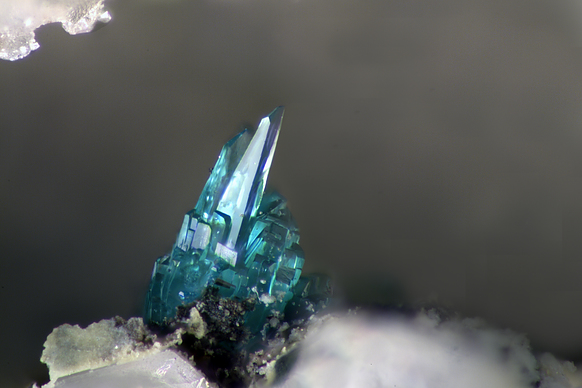Lautenthalite
A valid IMA mineral species
This page is currently not sponsored. Click here to sponsor this page.
About Lautenthalite
Formula:
PbCu4(SO4)2(OH)6 · 3H2O
Colour:
Green, bright blue
Lustre:
Vitreous
Hardness:
2½
Specific Gravity:
3.84 (Calculated)
Crystal System:
Monoclinic
Member of:
Name:
Named by O. Medenbach and W. Gebert in 1993 for the type occurrence at Lauthenthal, Germany, site of an ancient smelter.
Devilline Group.
The lead analogue of devilline and campigliaite.
Difficult to distinguish from both without analytical methods.
Found at several slag localities, and in mine waste dumps
The lead analogue of devilline and campigliaite.
Difficult to distinguish from both without analytical methods.
Found at several slag localities, and in mine waste dumps
Unique Identifiers
Mindat ID:
2347
Long-form identifier:
mindat:1:1:2347:0
GUID
(UUID V4):
(UUID V4):
c4f2fd29-b481-4349-bd54-a574f17c2c33
IMA Classification of Lautenthalite
Approved
First published:
1993
Classification of Lautenthalite
7.DF.70
7 : SULFATES (selenates, tellurates, chromates, molybdates, wolframates)
D : Sulfates (selenates, etc.) with additional anions, with H2O
F : With large and medium-sized cations
7 : SULFATES (selenates, tellurates, chromates, molybdates, wolframates)
D : Sulfates (selenates, etc.) with additional anions, with H2O
F : With large and medium-sized cations
31.6.1.2
31 : HYDRATED SULFATES CONTAINING HYDROXYL OR HALOGEN
6 : (AB)5(XO4)2Zq·xH2O
31 : HYDRATED SULFATES CONTAINING HYDROXYL OR HALOGEN
6 : (AB)5(XO4)2Zq·xH2O
Mineral Symbols
As of 2021 there are now IMA–CNMNC approved mineral symbols (abbreviations) for each mineral species, useful for tables and diagrams.
| Symbol | Source | Reference |
|---|---|---|
| Lth | IMA–CNMNC | Warr, L.N. (2021). IMA–CNMNC approved mineral symbols. Mineralogical Magazine, 85(3), 291-320. doi:10.1180/mgm.2021.43 |
Physical Properties of Lautenthalite
Vitreous
Transparency:
Transparent
Colour:
Green, bright blue
Streak:
White
Hardness:
2½ on Mohs scale
Cleavage:
Distinct/Good
Good on {001} and {010}
Good on {001} and {010}
Density:
3.84 g/cm3 (Calculated)
Optical Data of Lautenthalite
Type:
Biaxial (-)
RI values:
nα = 1.659(2) nβ = 1.703(2) nγ = 1.732(2)
2V:
Measured: 78° to 79°, Calculated: 78°
Max Birefringence:
δ = 0.073

Image shows birefringence interference colour range (at 30µm thickness)
and does not take into account mineral colouration.
and does not take into account mineral colouration.
Surface Relief:
High
Dispersion:
r < v strong
Optical Extinction:
Z = b; Y ∧ c = 4(1)°.
Pleochroism:
Weak
Comments:
X = pale blue; Y = Z = blue.
Chemistry of Lautenthalite
Mindat Formula:
PbCu4(SO4)2(OH)6 · 3H2O
Crystallography of Lautenthalite
Crystal System:
Monoclinic
Class (H-M):
2/m - Prismatic
Space Group:
P21/b
Cell Parameters:
a = 21.642(8) Å, b = 6.040(2) Å, c = 22.544(8) Å
β = 108.2(1)°
β = 108.2(1)°
Ratio:
a:b:c = 3.583 : 1 : 3.732
Unit Cell V:
2,799.47 ų (Calculated from Unit Cell)
Z:
8
Morphology:
Tabular crystals, sheaflike or irregular aggregates.
Twinning:
Polysynthetic on {100}.
X-Ray Powder Diffraction
Powder Diffraction Data:
| d-spacing | Intensity |
|---|---|
| 5.14 Å | (100) |
| 4.53 Å | (60) |
| 3.40 Å | (80) |
| 2.821 Å | (30) |
| 2.631 Å | (50) |
| 2.531 Å | (40) |
| 2.421 Å | (30) |
Comments:
Lautenthal, Germany. The data are from the type description.
Geological Environment
Paragenetic Mode(s):
| Paragenetic Mode | Earliest Age (Ga) |
|---|---|
| Stage 7: Great Oxidation Event | <2.4 |
| 47a : [Near-surface hydration of prior minerals] | |
| 47b : [Sulfates and sulfites] | |
| Stage 10b: Anthropogenic minerals | <10 Ka |
| 55 : Anthropogenic mine minerals | |
| 56 : Slag and smelter minerals (see also #51 and #55) |
Geological Setting:
Oxidation zone of Pb-Cu deposits.
Type Occurrence of Lautenthalite
General Appearance of Type Material:
Bright blue crystals up to 0.5 x 0.3 x 0.03 mm, and as sheaflike aggregates.
Place of Conservation of Type Material:
Institut fur Mineralogie, Ruhr-Universitat, Bochum, Germany.
Geological Setting of Type Material:
Smelter slag.
Associated Minerals at Type Locality:
Synonyms of Lautenthalite
Other Language Names for Lautenthalite
German:Lautenthalit
Spanish:Lautenthalita
Relationship of Lautenthalite to other Species
Member of:
Other Members of this group:
| Aldridgeite | (Cd,Ca)(Cu,Zn)4(SO4)2(OH)6 · 3H2O | Mon. 2/m : B2/b |
| Campigliaite | Mn2+Cu4(SO4)2(OH)6 · 4H2O | Mon. 2 : B2 |
| Devilline | CaCu4(SO4)2(OH)6 · 3H2O | Mon. 2/m : P21/b |
| Kobyashevite | Cu5(SO4)2(OH)6 · 4H2O | Tric. 1 : P1 |
| Orthoserpierite | Ca(Cu,Zn)4(SO4)2(OH)6 · 3H2O | Orth. mm2 : Pca21 |
| Serpierite | Ca(Cu,Zn)4(SO4)2(OH)6 · 3H2O | Mon. 2/m : B2/b |
| Unnamed (Dimorph of Devilline) | CaCu4(SO4)2(OH)6 · 3H2O | Mon. 2/m : P21/b |
Common Associates
Associated Minerals Based on Photo Data:
| 29 photos of Lautenthalite associated with Langite | Cu4(SO4)(OH)6 · 2H2O |
| 27 photos of Lautenthalite associated with Anglesite | PbSO4 |
| 14 photos of Lautenthalite associated with Wroewolfeite | Cu4(SO4)(OH)6 · 2H2O |
| 13 photos of Lautenthalite associated with Linarite | PbCu(SO4)(OH)2 |
| 12 photos of Lautenthalite associated with Cerussite | PbCO3 |
| 11 photos of Lautenthalite associated with Ramsbeckite | (Cu,Zn)15(SO4)4(OH)22 · 6H2O |
| 11 photos of Lautenthalite associated with Schulenbergite | (Cu,Zn)7(SO4)2(OH)10 · 3H2O |
| 7 photos of Lautenthalite associated with Sphalerite | ZnS |
| 6 photos of Lautenthalite associated with Susannite | Pb4(CO3)2(SO4)(OH)2 |
| 5 photos of Lautenthalite associated with Goethite | α-Fe3+O(OH) |
Related Minerals - Strunz-mindat Grouping
| 7.DF. | Aldridgeite | (Cd,Ca)(Cu,Zn)4(SO4)2(OH)6 · 3H2O |
| 7.DF. | Chromschieffelinite | Pb10Te6+6O20(OH)14(CrO4)(H2O)5 |
| 7.DF. | Alcaparrosaite | K3Ti4+Fe3+(SO4)4O(H2O)2 |
| 7.DF. | Bairdite | Pb2Cu2+4Te6+2O10(OH)2(SO4) · H2O |
| 7.DF. | Carlsonite | (NH4)5Fe3+3O(SO4)6 · 7H2O |
| 7.DF. | Ammoniomathesiusite | (NH4)5(UO2)4(SO4)4(VO5) · 4H2O |
| 7.DF. | Erssonite | Mg7Fe3+2(OH)18[Ca(H2O)6](SO4)2 · 12H2O |
| 7.DF. | Flaggite | Pb4Cu2+4Te6+2(SO4)2O11(OH)2(H2O) |
| 7.DF. | Poellmannite | Ca6Al3(OH)18[Na(H2O)6](SO4)2 · 6H2O |
| 7.DF. | Haywoodite | [Pb(H2O)10][Zn12(OH)20(H2O)(SO4)3] |
| 7.DF. | Cherokeeite | [Pb2Zn(OH)4](SO4) · H2O |
| 7.DF. | Cuprocherokeeite | [Pb8Zn3Cu2+(OH)16](SO4)4 · 4H2O |
| 7.DF. | Tzeferisite | CaZn8(SO4)2(OH)12Cl2(H2O)9 |
| 7.DF.05 | Uklonskovite | NaMg(SO4)F · 2H2O |
| 7.DF.10 | Kainite | KMg(SO4)Cl · 3H2O |
| 7.DF.10 | Kaliochalcite | KCu2(SO4)2[(OH)(H2O)] |
| 7.DF.15 | Natrochalcite | NaCu2(SO4)2(OH) · 2H2O |
| 7.DF.17 | Unnamed (Ba-Sb Silicate-Sulphate-Hydroxide-Hydrate) | Ba3Sb5+[(Si,S)O3(OH)]2(OH,O)6 · 3H2O |
| 7.DF.17 | Genplesite | Ca3Sn(SO4)2(OH)6 · 3H2O |
| 7.DF.20 | Metasideronatrite | Na2Fe(SO4)2(OH) · H2O |
| 7.DF.20 | Sideronatrite | Na2Fe(SO4)2(OH) · 3H2O |
| 7.DF.25 | Despujolsite | Ca3Mn4+(SO4)2(OH)6 · 3H2O |
| 7.DF.25 | Fleischerite | Pb3Ge(SO4)2(OH)6 · 3H2O |
| 7.DF.25 | Schaurteite | Ca3Ge(SO4)2(OH)6 · 4H2O |
| 7.DF.25 | Mallestigite | Pb3Sb5+(SO4)(AsO4)(OH)6 · 3H2O |
| 7.DF.30 | Slavíkite | (H3O+)3Mg6Fe15(SO4)21(OH)18 · 98H2O |
| 7.DF.35 | Metavoltine | K2Na6Fe2+Fe3+6O2(SO4)12 · 18H2O |
| 7.DF.40 | Lannonite | Mg2Ca4Al4(SO4)8F8 · 24H2O |
| 7.DF.40 | Vlodavetsite | AlCa2(SO4)2F2Cl · 4H2O |
| 7.DF.45 | Peretaite | Ca(SbO)4(SO4)2(OH)2 · 2H2O |
| 7.DF.50 | Gordaite | NaZn4(SO4)(OH)6Cl · 6H2O |
| 7.DF.50 | Calamaite | Na2TiO(SO4)2 · 2H2O |
| 7.DF.52 | Scordariite | K8(Fe3+0.67◻0.33)[Fe3+3O(SO4)6]2 · 14H2O |
| 7.DF.52 | Huizingite-(Al) | [(NH4)9(SO4)2][(Al,Fe3+)3(OH)2(H2O)4(SO4)6] |
| 7.DF.55 | Clairite | (NH4)2Fe3(SO4)4(OH)3 · 3H2O |
| 7.DF.55 | Giacovazzoite | K5Fe3+3O(SO4)6 · 10H2O |
| 7.DF.57 | Magnanelliite | K3Fe3+2(SO4)4(OH)(H2O)2 |
| 7.DF.60 | Arzrunite | Cu4Pb2(SO4)(OH)4Cl6 · 2H2O (?) |
| 7.DF.60 | Evdokimovite | Tl4(VO)3(SO4)5(H2O)5 |
| 7.DF.62 | Bridgesite-(Ce) | CaCe2Cu6(SO4)4(OH)12 · 8H2O |
| 7.DF.65 | Elyite | Pb4Cu(SO4)O2(OH)4 · H2O |
| 7.DF.70 | Yecoraite | Fe3+3Bi5(Te6+O4)2(Te4+O3)O9 · 9H2O |
| 7.DF.75 | Riomarinaite | Bi(SO4)(OH) · H2O |
| 7.DF.80 | Dukeite | Bi3+24Cr6+8O57(OH)6 · 3H2O |
Fluorescence of Lautenthalite
Not fluorescent.
Other Information
Notes:
Reacts readily with HCl to form a residue of PbS04.
Health Risks:
No information on health risks for this material has been entered into the database. You should always treat mineral specimens with care.
Internet Links for Lautenthalite
mindat.org URL:
https://www.mindat.org/min-2347.html
Please feel free to link to this page.
Please feel free to link to this page.
Search Engines:
External Links:
Mineral Dealers:
References for Lautenthalite
Localities for Lautenthalite
Locality List
 - This locality has map coordinates listed.
- This locality has map coordinates listed.
 - This locality has estimated coordinates.
ⓘ - Click for references and further information on this occurrence.
? - Indicates mineral may be doubtful at this locality.
- This locality has estimated coordinates.
ⓘ - Click for references and further information on this occurrence.
? - Indicates mineral may be doubtful at this locality.
 - Good crystals or important locality for species.
- Good crystals or important locality for species.
 - World class for species or very significant.
(TL) - Type Locality for a valid mineral species.
(FRL) - First Recorded Locality for everything else (eg varieties).
- World class for species or very significant.
(TL) - Type Locality for a valid mineral species.
(FRL) - First Recorded Locality for everything else (eg varieties).
All localities listed without proper references should be considered as questionable.
Austria | |
| 50. +1 other reference |
France | |
| Y. Vessely collection |
| Lheur et al. (1998) +1 other reference |
Germany | |
| Confirmed by mr. Steve Rust. |
| Medenbach et al. (1993) |
Greece | |
| |
| |
Italy | |
| Jansen et al. (1998) |
Japan | |
| Yamada et al. (2000) +1 other reference |
UK | |
| Jarvis +2 other references |
| American Mineralogist +3 other references |
| |
| Rust et al. (1988) | |
| Mason et al. (1995) |
| S Rust collection |
| S Rust collection |
| Green et al. (1996) +1 other reference |
| Day (1999) |
| |
USA | |
| A. Kampf or C. Emproto PXRD and/EDS ... |
Quick NavTopAbout LautenthaliteUnique IdentifiersIMA Classification Classification Mineral SymbolsPhysical Properties Optical Data Chemistry Crystallography X-Ray Powder DiffractionGeological EnvironmentType Occurrence SynonymsOther LanguagesRelationshipsCommon AssociatesStrunz-MindatFluorescence Other InformationInternet Links References Localities Locality List







 symbol to view information about a locality.
The
symbol to view information about a locality.
The 




Meadowfoot Smelter slag locality, Wanlockhead, Dumfries and Galloway, Scotland, UK